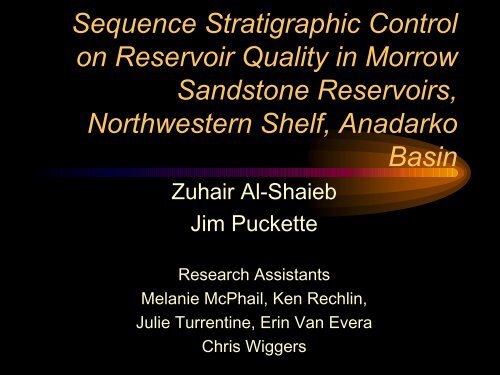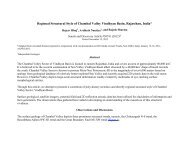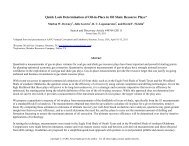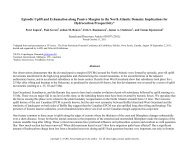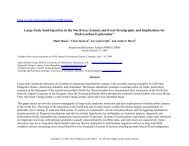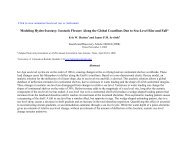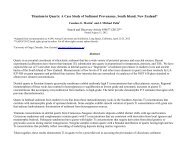Sequence Stratigraphic Control on Reservoir Quality in Morrow ...
Sequence Stratigraphic Control on Reservoir Quality in Morrow ...
Sequence Stratigraphic Control on Reservoir Quality in Morrow ...
You also want an ePaper? Increase the reach of your titles
YUMPU automatically turns print PDFs into web optimized ePapers that Google loves.
<str<strong>on</strong>g>Sequence</str<strong>on</strong>g> <str<strong>on</strong>g>Stratigraphic</str<strong>on</strong>g> <str<strong>on</strong>g>C<strong>on</strong>trol</str<strong>on</strong>g><br />
<strong>on</strong> <strong>Reservoir</strong> <strong>Quality</strong> <strong>in</strong> <strong>Morrow</strong><br />
Sandst<strong>on</strong>e <strong>Reservoir</strong>s,<br />
Northwestern Shelf, Anadarko<br />
Bas<strong>in</strong><br />
Zuhair Al-Shaieb<br />
Jim Puckette<br />
Research Assistants<br />
Melanie McPhail, Ken Rechl<strong>in</strong>,<br />
Julie Turrent<strong>in</strong>e, Er<strong>in</strong> Van Evera<br />
Chris Wiggers
Objectives<br />
• To def<strong>in</strong>e depositi<strong>on</strong>al facies, sequence<br />
stratigraphic framework and reservoir<br />
characterizati<strong>on</strong> of the Upper <strong>Morrow</strong><br />
reservoir.<br />
• Applicati<strong>on</strong> of the above to explorati<strong>on</strong><br />
and sec<strong>on</strong>dary recovery projects.
Paleogeology of the Anadarko bas<strong>in</strong> dur<strong>in</strong>g late <strong>Morrow</strong>an time.<br />
(After Rascoe, and Adler, 1983).
FIELDS OF STUDY
92%<br />
8%<br />
96%<br />
4%<br />
23% 3%<br />
74%<br />
<strong>Reservoir</strong>s are primarily channel-fill fluvial<br />
sandst<strong>on</strong>es with<strong>in</strong> the complex valley fill deposits.<br />
Valleys were cut <strong>in</strong>to the underly<strong>in</strong>g shelf muds<br />
dur<strong>in</strong>g<br />
sea level lowstands, and filled<br />
dur<strong>in</strong>g transgressive episodes.<br />
Upper <strong>Morrow</strong> sandst<strong>on</strong>e reservoirs have<br />
produced <strong>in</strong> excess of 280 milli<strong>on</strong> barrels of oil<br />
and 3.3 TCF gas from the northwestern shelf of<br />
the Anadarko bas<strong>in</strong> and Hugot<strong>on</strong> embayment <strong>in</strong><br />
Oklahoma, Texas, and Kansas.
<str<strong>on</strong>g>Stratigraphic</str<strong>on</strong>g> and Lithologic<br />
column of <strong>Morrow</strong> <strong>in</strong> the<br />
Oklahoma panhandle.<br />
Model cross-secti<strong>on</strong> of<br />
typical <strong>in</strong>cised-valley.<br />
Modified from Harris<strong>on</strong>, 1990, and Luchtel, 1999.
Case Study 1<br />
NE Hardesty Field Texas<br />
County, Oklahoma
Total Producti<strong>on</strong>: 10,162,060 BBLS<br />
1,602,360 MCF
A A’<br />
Incised valley <strong>in</strong> the NE<br />
Hardesty Field.
Case Study II<br />
NE Eva Field<br />
Texas County,<br />
Oklahoma
Total Producti<strong>on</strong>: 2,118,433 BBLS<br />
14,063,346 MCF
B B’<br />
Thickness map of<br />
upper <strong>Morrow</strong><br />
Purdy Sandst<strong>on</strong>e
Case Study III<br />
Carthage Field<br />
Texas County,<br />
Oklahoma
Total Producti<strong>on</strong>: 1,974,076 BBLS<br />
44,397,505 MCF
Thickness map<br />
of lower Purdy<br />
Sandst<strong>on</strong>e<br />
C C’
UPPER<br />
MORROWAN<br />
FACIES
6<br />
5<br />
4<br />
3<br />
2<br />
1<br />
6<br />
Lithofacies
Fluvial Facies<br />
1<br />
2<br />
6<br />
5<br />
4<br />
3<br />
2<br />
1<br />
6<br />
3<br />
4
Estuar<strong>in</strong>e Facies<br />
6<br />
5<br />
4<br />
3<br />
2<br />
1<br />
6<br />
5<br />
E-1 Interbedded sandst<strong>on</strong>e and<br />
shale with trace fossils.
Mar<strong>in</strong>e Facies<br />
6<br />
5<br />
4<br />
3<br />
2<br />
1<br />
6<br />
6<br />
M-1 Dark gray shale<br />
with abundant mar<strong>in</strong>e fossils.
PETROLEUM INC. HENDRIX #3<br />
CARTHAGE FIELD, TEXAS<br />
CO., OKLAHOMA.
Hendrix #3<br />
M-2<br />
M-1<br />
F-2<br />
F-1<br />
E-2<br />
E-1
F-1<br />
F-2<br />
E-2<br />
E-2<br />
M-2<br />
Hendrix #3<br />
M-1
Anadarko Petroleum NE Hardesty Unit 11-2,<br />
NE Hardesty Field,<br />
Texas Co., Oklahoma
NE Hardesty #11-2<br />
F-3<br />
F-4<br />
F-2<br />
F-1<br />
M-1
NE Hardesty #11-2<br />
F-2<br />
F-4<br />
6238.5<br />
F-1 M-1 F-3<br />
F-2
Evoluti<strong>on</strong> of <strong>in</strong>cised<br />
valley-fill deposits
After Wheeler and others 1990
After Wheeler and others, 1990.
Valley-fill depositi<strong>on</strong>al<br />
sequence
E-2<br />
M-2<br />
TSE<br />
MFS<br />
E-1, E-2, AND M-2<br />
Estuary / bay<br />
(shale, sandst<strong>on</strong>e)<br />
(TST)<br />
F-4<br />
Aband<strong>on</strong>ed channel<br />
(clayst<strong>on</strong>e, coal)<br />
(TST)<br />
SB<br />
F-3<br />
F-2<br />
F-2, F-3<br />
Fluvial<br />
(sandst<strong>on</strong>es)<br />
(TST)<br />
MFS<br />
M T Mar<strong>in</strong>e<br />
Mud (HST)<br />
After Wheeler and others, 1990.<br />
F-1 Fluvial<br />
channel lag (LST)
<str<strong>on</strong>g>Sequence</str<strong>on</strong>g> <str<strong>on</strong>g>Stratigraphic</str<strong>on</strong>g><br />
Systems Tracts:<br />
Successi<strong>on</strong> of Upper <strong>Morrow</strong>an
Evoluti<strong>on</strong> of Upper <strong>Morrow</strong>an Successi<strong>on</strong>s<br />
In Study Area<br />
A<br />
B<br />
After Shepherd, 2000.<br />
After Luchtel, 1999.<br />
C<br />
After Shepherd, 2000.
B<br />
After Shepherd, 2000.<br />
A<br />
F-4<br />
F-4<br />
paleosol<br />
F-2<br />
F-2<br />
C<br />
F-3<br />
M-1<br />
Photomicrograph show<strong>in</strong>g caliche <strong>in</strong> paleosol. Fergus<strong>on</strong> #1<br />
From Harris<strong>on</strong>, 1990.
<strong>Reservoir</strong> Characterizati<strong>on</strong>
Petrology and Diagenesis<br />
A<br />
B
Detrital C<strong>on</strong>stituents<br />
Q<br />
Q<br />
PL<br />
A<br />
C<br />
SRF<br />
B<br />
GRF<br />
D
Diagenetic C<strong>on</strong>stituents<br />
K<br />
Authigenic Kaol<strong>in</strong>ite (K) derived from<br />
dissoluti<strong>on</strong> of feldspars that partiti<strong>on</strong>s<br />
pore space.<br />
A<br />
G<br />
Bioclast filled with<br />
<strong>in</strong>traparticle glauc<strong>on</strong>ite (G).<br />
C<br />
K<br />
Kaol<strong>in</strong>ite (K)“books” fill<strong>in</strong>g<br />
center of pores while chlorite<br />
coats quartz gra<strong>in</strong>s.<br />
B<br />
D<br />
Thermal dolomite (D) with<br />
sparry calcite cement.<br />
D
Porosity<br />
Φ<br />
F<br />
A<br />
C<br />
EP<br />
IMP<br />
B<br />
D
Hendrix #3<br />
Z<strong>on</strong>e A<br />
Northeast Hardesty<br />
#11-2<br />
F-2<br />
F-2<br />
Porosity: 18.76%<br />
Permeability: 269.7 md<br />
1 mm<br />
Porosity: 16.84%<br />
Permeability: 127.109 md
Z<strong>on</strong>e B<br />
Northeast Hardesty<br />
#11-2<br />
F-2<br />
Porosity: 17.93%<br />
Permeability: 33.63 md
Z<strong>on</strong>e C 1<br />
F-4<br />
Northeast Hardesty<br />
#11-2<br />
E-1<br />
Porosity: 12.87%<br />
Permeability: 0.016 md<br />
F-1
Z<strong>on</strong>e C 2<br />
Hendrix #3<br />
F-1<br />
Porosity: 6.62%<br />
E-1
Z<strong>on</strong>e D<br />
Northeast Hardesty<br />
#11-2<br />
M-1<br />
Hendrix #3<br />
M-2<br />
M-2
Pressure Gradient Map<br />
of the <strong>Morrow</strong><br />
<strong>Reservoir</strong>s <strong>in</strong> Anadarko<br />
Bas<strong>in</strong> and Oklahoma<br />
Panhandle
Normal pressure gradient is 0.465 psi/ft. Pressure<br />
gradients <strong>in</strong> underpressured Texas County<br />
<strong>Morrow</strong> reservoirs are approximately 0.3 psi/ft.
(Locati<strong>on</strong>s of po<strong>in</strong>ts<br />
<strong>on</strong> pressuregradient<br />
map)<br />
Pressure Depth Profile at po<strong>in</strong>t C<br />
Pressure Depth Profile at po<strong>in</strong>t G<br />
Pressure Depth Profile at po<strong>in</strong>t F<br />
Pressure Depth Profile at po<strong>in</strong>t A
CONCLUSIONS<br />
! The upper <strong>Morrow</strong> reservoirs <strong>in</strong> Texas County, Oklahoma<br />
exhibit a variety of facies typical of <strong>in</strong>cised valley systems.<br />
! Lowstand systems tract deposits are limited to clay clast<br />
c<strong>on</strong>glomerates (F-1). Transgressive systems tract deposits are<br />
represented by fluvial (F-2, F-3, and F-4) lithofacies as well as<br />
the estuar<strong>in</strong>e (E-1 and E-2) lithofacies .<br />
! Three major lithofacies were recognized: fluvial, estuar<strong>in</strong>e, and<br />
mar<strong>in</strong>e. Us<strong>in</strong>g textural, sedimentological, structural, and<br />
depositi<strong>on</strong>al parameters, each major lithofacies was<br />
subdivided. Fluvial facies c<strong>on</strong>sist of F-1, F-2, F-3 and F-4.<br />
Estuar<strong>in</strong>e facies c<strong>on</strong>ta<strong>in</strong> E-1 and E-2; mar<strong>in</strong>e facies M-1 and<br />
! M-2.
CONCLUSIONS<br />
! Petrographic, petrophysical, and core measured<br />
porosity/permeability data <strong>in</strong>dicate that F2 and F3 fluvial facies<br />
are better quality reservoirs.<br />
! Authigenic kaol<strong>in</strong>ite and clay matrix drastically reduce<br />
permeability <strong>in</strong> various lithofacies. Carb<strong>on</strong>ate cement, and to a<br />
lesser extent dolomite, reduce both porosity and permeability.<br />
! In summary, the F2 and F3 lithofacies have better potential of<br />
be<strong>in</strong>g high-volume oil- and gas-produc<strong>in</strong>g reservoirs.


